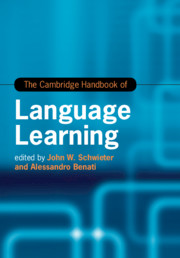Book contents
- The Cambridge Handbook of Language Learning
- Cambridge Handbooks in Language and Linguistics
- The Cambridge Handbook of Language Learning
- Copyright page
- Contents
- Figures
- Tables
- Contributors
- Acknowledgements
- Introduction
- Part I Theories
- Part II Methods
- Part III Skill Development
- Part IV Individual Differences
- Part V Pedagogical Interventions and Approaches
- Part VI Context and Environment
- Part VII Moving Forward
- Index
- References
Part V - Pedagogical Interventions and Approaches
Published online by Cambridge University Press: 25 June 2019
- The Cambridge Handbook of Language Learning
- Cambridge Handbooks in Language and Linguistics
- The Cambridge Handbook of Language Learning
- Copyright page
- Contents
- Figures
- Tables
- Contributors
- Acknowledgements
- Introduction
- Part I Theories
- Part II Methods
- Part III Skill Development
- Part IV Individual Differences
- Part V Pedagogical Interventions and Approaches
- Part VI Context and Environment
- Part VII Moving Forward
- Index
- References
Summary
The role of instruction in L2 acquisition has been a key question and a theoretical issue in the field. It was directly addressed by Long (1983) in a paper in which he presented the results of several classroom-based empirical studies, all addressing the question of whether instruction can be beneficial for L2 learners. In his review, he considered eleven studies which examined whether the learners receiving instruction achieved a higher level of proficiency than those learners who did not. In these eleven studies, classroom only, naturalistic exposure only, and classroom plus naturalistic exposure were compared. Long concluded that the overall findings indicate that instruction is beneficial for adults (intermediate and advanced stages) as well as for children. It is beneficial both in acquisition-rich contexts (i.e., in which learners are exposed to the target language outside the classroom context) and acquisition-poor environments (i.e., in which learners are exposed to the target language only in a classroom context). Such benefits emerge despite the way proficiency is measured. Long concluded that a combination of instruction and naturalistic exposure to the input were optimal conditions as instruction seems to have an effect on the rate of and ultimate success in L2 acquisition.
- Type
- Chapter
- Information
- The Cambridge Handbook of Language Learning , pp. 475 - 646Publisher: Cambridge University PressPrint publication year: 2019



